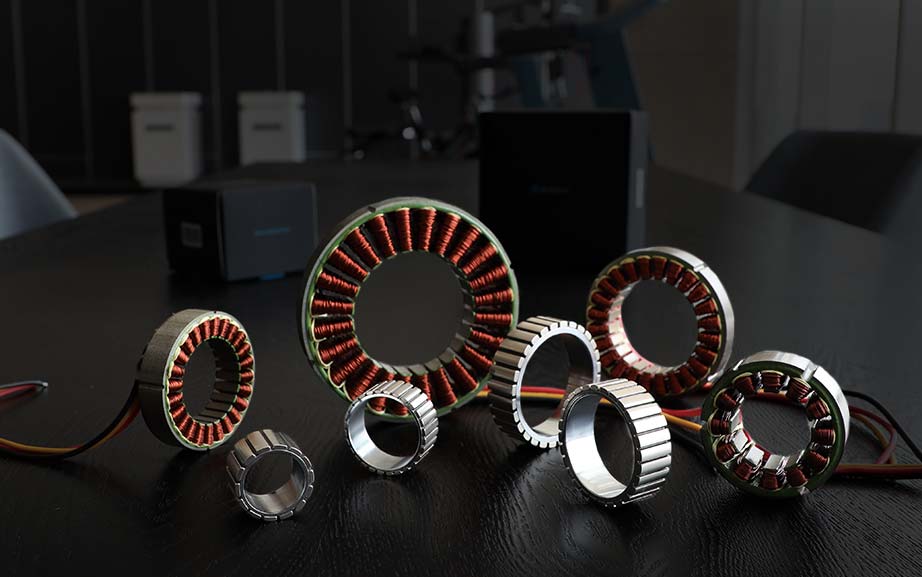
Brushless DC Motors: A Comprehensive Overview
Today, we will discuss brushless DC motors in five aspects: working principles, components, applications, selection, and usage recommendations.
How Brushless DC Motors Operate
The working principle of a brushless DC motor is based on electromagnetic induction and the interaction of magnetic fields. It uses an electronic commutation system to control the flow of current, creating a rotating magnetic field that drives the rotor. The specific process is as follows:
Magnetic Interaction: The rotor is equipped with permanent magnets, and the stator has several coils (windings). When current passes through the stator windings, a magnetic field is generated, which interacts with the permanent magnets on the rotor, producing torque.
Electronic Commutation: The electronic controller controls the on and off of the current based on the rotor's position (detected by Hall sensors or other position sensors), achieving precise commutation and maintaining continuous rotation of the rotor.
Feedback Control: Most brushless DC motors use position sensors (such as Hall sensors) to detect the rotor's position in real time and feed the information back to the controller, which adjusts the current direction and magnitude for precise control.
Components of Brushless DC Motors
From the working principle, we can deduce that brushless DC motors mainly consist of the following three parts:
Rotor: Typically composed of a core with installed permanent magnets. The rotor is the rotating part of the brushless DC motor, producing torque through the interaction of the magnetic field generated by the permanent magnets and the electromagnetic field of the stator. The brushless design better eliminates wear, enhancing motor life and reliability.
Stator: Composed of multiple electromagnetic coils (windings). The stator generates a rotating magnetic field that drives the rotor. It has advantages such as high efficiency, low noise, and low heat generation.
Electronic Controller: Includes power switches, microcontrollers, and position sensors (such as Hall sensors). It controls the on and off and direction of the current, performs electronic commutation, and achieves precise control of the motor. It also features fast response and programmable control.
Advantages of Brushless DC Motor Applications
CubeMars brushless DC motors are commonly used in exoskeleton robots and industrial collaborative robot arms. What advantages do they offer?
High Power Density: Brushless DC motors can provide high power density, suitable for exoskeleton robots and industrial collaborative robot arms with high volume and weight requirements.
High Efficiency and Energy Saving: The high efficiency of brushless DC motors extends battery life, suitable for long-duration applications.
Smooth Operation and Low Noise: Smooth operation and low noise improve user comfort and the quietness of the working environment.
Precise Control: Brushless DC motors can achieve precise position and speed control through electronic control, meeting complex motion requirements.
Low Maintenance Requirements: The brushless design reduces maintenance needs, lowering operating costs.
How to Choose a Good Brushless DC Motor
When selecting a good brushless DC motor, consider the following six aspects:
Motor Rated Power and Torque: Choose the appropriate power and torque based on the application requirements to meet load demands.
Speed Range: Determine the required speed range to ensure the motor can operate stably within the needed speed range.
Efficiency: High-efficiency motors reduce energy consumption and improve endurance.
Controller Compatibility: Selec t a controller that matches the motor to ensure control precision and response speed.
Size and Weight: Choose the appropriate motor size based on installation space and weight requirements.
Heat Dissipation Performance: Good heat dissipation extends motor life and prevents overheating.
Recommendations for Using Brushless DC Motors
When using brushless DC motors, consider the following:
Correct Installation: Ensure the motor and controller are correctly connected to avoid looseness and poor contact.
Regular Maintenance: Although brushless DC motors require less maintenance, regular inspection of coils, connecting wires, and sensors is still necessary.
Environmental Adaptability: Ensure the motor operates in suitable temperature and humidity conditions to prevent overheating or dampness.
Load Matching: Avoid long-term overload operation of the motor to extend its service life.
Control Parameter Settings: Set control parameters reasonably according to specific application requirements, such as current limits, speed range, and acceleration.
If you have any further questions about brushless DC motors, feel free to consult us!
